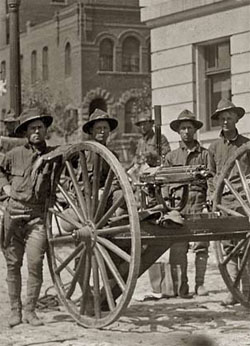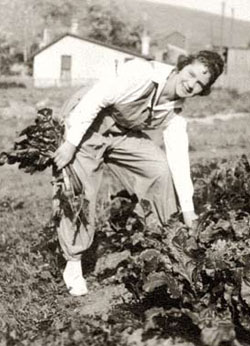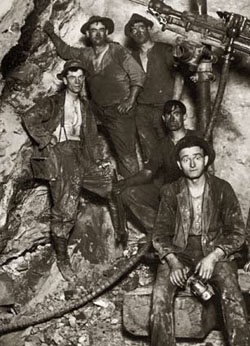Montana: Stories of the Land
Companion Website and Online Teacher's Guide
Chapter 16 - Montana and World War I, 1914-1918
Chapter 1 - Montana: Where the Land Writes History
Chapter 2 - People of the Dog Days
Chapter 3 - From Dog Days to Horse Warriors
Chapter 4 - Newcomers Explore the Region
Chapter 5 - Beaver, Bison, and Black Robes
Chapter 6 - Montana's Gold and Silver Boom
Chapter 7 - Two Worlds Collide
Chapter 8 - Livestock and the Open Range
Chapter 9 - Railroads Link Montana to the Nation
Chapter 10 - Politics and the Copper Kings
Chapter 11 - The Early Reservation Years
Chapter 12 - Logging in the "High Lonesome"
Chapter 13 - Homesteading This Dry Land
Chapter 14 - Towns Have Lives, Too
Chapter 15 - Progressive Montana
Chapter 16 - Montana and World War I
Chapter 17 - Montanans on the Move
Chapter 18 - The Great Depression Transforms Montana
Chapter 19 - World War II in Montana
Chapter 20 - Building a New Montana
Chapter 21 - A People's Constitution
Chapter 22 - Living in a New Montana
Educator Resources
For simplicity's sake, the textbook separates the intertwined histories of radical political movements (discussed in chapter 15) and the conservative response, particularly as represented by the lynching of Frank Little and the passage of the Montana Sedition Act (discussed in chapter 16). However, these stories are clearly interconnected. Ideally, then, this chapter will be taught in tandem with Chapter 15, "Progressive Montana." Equally, educators may find links listed on Chapter 15's companion web pages of use when teaching this chapter.
Takeaways
-
Inspired by reading specialist Tammy Elser, who was in turn inspired by SKC graduate Taylor Crawford, we've created a "Takeaway" bookmark for every chapter of Montana: Stories of the Land. Before starting a chapter, print and cut out these bookmarks and distribute them to your students. Ask them to use the Takeaway to summarize the GIST of what they learn from reading assigned sections of the chapter. Remind them that they don't have much room, so they'll need to think before they write down the most important idea they want to take away from the section. Learn a little more about the GIST strategy.
-
Even though we've created Takeaways for every chapter, we don't recommend you have your students complete a Takeaway for every section of every chapter they read. That would be exceedingly tedious. However, used appropriately, they can be a useful tool for encouraging reflection and teaching students how to summarize information.
Websites and Online Lesson Plans
-
Created to commemorate the centennial of the U.S. entry into World War I, Montana and the Great War provides resources to investigate the war's transformative and complicated legacy in our home state, including a lesson plan, story maps, digitized articles, an online museum exhibit, and a World War I scavenger hunt. An answer key is posted under Chapter 16 answer keys in the password protected area of this site.
-
The Annotated Resource Set Montana and World War I, 1914-1918, includes links to photographs, maps, illustrations, and documents relating to that era. Many, but not all, of the images were also used to illustrate Chapter 16 of Montana: Stories of the Land. These sources can be used to build PowerPoints or to create DBQs or other primary-source based activities.
-
The NEH features the lesson plan "United States Entry into World War I: Two Diametrically Opposed Views" among other lessons on the war.
-
Montana The Magazine of Western History created a discussion guide for "A Reexamination of the Granite Mountain-Speculator Fire," by James D. Harrington, an article published in the Autumn 1998 issue. The article's full text (but not its pictures) is posted online.
-
Discover more about Butte's rich labor history in "When Toil Meant Trouble: Butte's Labor Heritage," by George Everett.
-
Two of the complementary "Learning from Historical Documents" units created to accompany Chapter 12 also work well with this chapter. These units feature letters (from opposing points of view) regarding the Industrial Workers of the World and the 1917 timber strike.
-
The Montana Sedition Project's website on the Montana Sedition Act is a rich and fascinating resource. (Please note that primary sources are quoted verbatim and in a few instances include obscenities.)
-
The University of Montana Special Collections Library has created an online exhibit: World War I Propaganda.
Videos or DVDs
-
Jailed for Their Words: When Free Speech Died in Wartime America - 60 minutes.
-
Chapter 1, "When Copper Was King," (22 minutes) and Chapter 12, "Montana's Response to Global Conflict," (17 minutes) of Montana Mosaic: 20th Century People and Events. Chapter 1 discusses labor strife and Chapter 12 focuses on Jeannette Rankin's story. (Check your library. OPI donated a copy of this DVD to every public school in Montana. The DVD is also available as streaming video.) Find User Guides with discussion questions here.
-
Unladylike2020: Unsung Women Who Changed America--Jeannette Rankin: First Woman Member of the U.S. Congress - 12:30 minutes.
-
Paupers Dream: Tribute to the Montana Hard Rock Miner, Joseph Campanella - 58 minutes. Buy the DVD or view on YouTube.
-
Blue Death: The 1918 Influenza in Montana- 55 minutes.
-
No Ordinary Time - 18 minutes. (This was a student-created film exploring the cultural impacts of the 1918 Spanish flu in Montana and how it relates to COVID-19.
-
American Experience: The Great War - 3 parts, each 114 minutes.
Possible Field Trips: View the Map
-
World Museum of Mining, Butte
-
Granite Mountain Memorial, Butte
Chapter 16 Test and Answer Keys Page
The tests and answer keys are password protected.
You can contact us to receive the password:
- Martha Kohl - call (406) 444-4790 or email mkohl@mt.gov
- Melissa Hibbard - call (406) 444-4741 or email Melissa.Hibbard@mt.gov
Or, if you used the old system, the original username is now the new password. You will be asked for this case-sensitive password every time you open a new document.
Alignment to ELA Common Core Standards
Content Standards and Essential Understandings Regarding Montana Indians (EU)




